Commodore Amiga 601 Expansion Memory Module (Boxed)
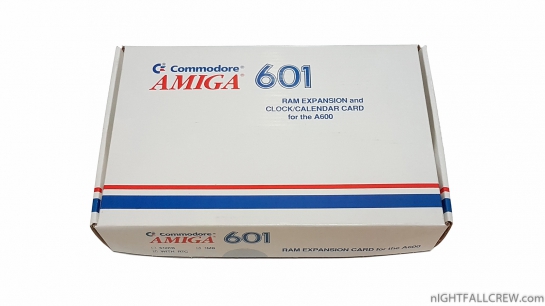
The Commodore A601 provide 512k/1Mb of additional memory for the Commodore Amiga 600.
The RAM Expansion Module also provides you a real-time clock with rechargeable battery.
Gallery:

The Commodore A601 provide 512k/1Mb of additional memory for the Commodore Amiga 600.
The RAM Expansion Module also provides you a real-time clock with rechargeable battery.
Gallery:
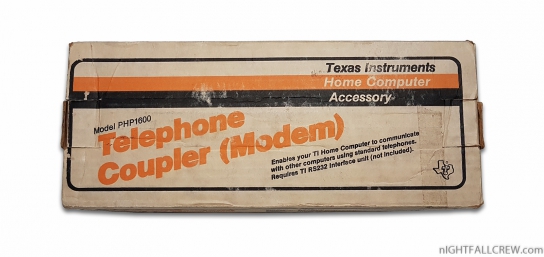
The PHP-1600 Telephone Coupler (Modem) enables your TI Home Computer to communicate via a standard telephone.
With a TI Telephone Coupler (Modem) and the TI RS232 Interface (sold separately), your Home Computer can communicate with similarly equipped computers.
You can send and receive messages and data, transfer programs between Home Computers, and access information from consumer data services you subscribe to.
Description/Specs:
Gallery:
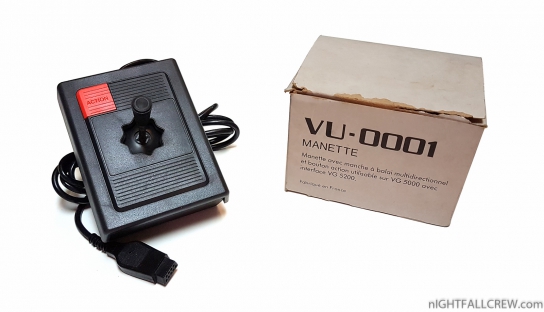
The VU-0001 joystick can be used with the VG-5000 Computer series equipped with a VG-5200 interface.
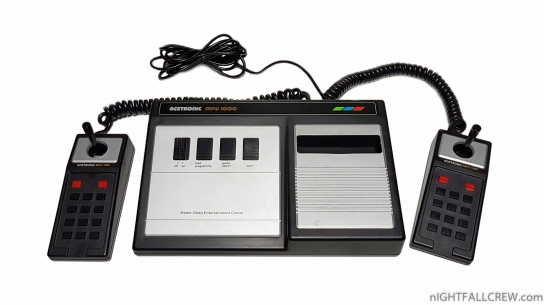
The 1292 Advanced Programmable Video System (Acetronic MPU-1000) is a home video game console released by European company Audiosonic in 1978.
It is part of a group of software-compatible consoles which include the Interton VC-4000 and the Voltmace Database. The 1292 Advanced Programmable Video System included its power pack inside the console instead of an exterior power pack.
Specifications:
Graphics:
Misc:
User programming:
An expensive (£49 in the UK in 1977) Hobby Module was available which gave 6.5 kb of user-programmable memory and had a 5 pin DIN socket to allow software to be saved to a cassette tape player.
This converted the unit into a halfway house between a home computer and an ordinary gaming console.
The user had to be familiar with programming in Signetics 2650 assembly language and the unconventional ways and register architecture of the Signetics 2650 processor. For example, on many other processors an opcode 0 indicates “no operation” whereas on the 2650 it instructs the processor to Branch To Address In Immediate Register B.
This was a source of many software debugging hassles for budding home programmers.
Gallery:
source: wikipedia
Thanks to my friend Andry for the donation of this DataRecorder.
Laser Slim Line Computer DataRecorder (Model DR-15).
Gallery:
The Commodore Monitor 1960 may have been made by Daewoo (Korea) or a Taiwan company, or may be an OEMed Panasonic Panasync. The tube is made by Hitachi/Panasonic.
There has been some debate over whether it is a true multisync or a trisync monitor. Reports have been provided that indicate it can handle Super72 screen modes at about 23 kHz, and the manual says it can sync up to 38 kHz. It may be a sort of hybrid, with a wide “window” in the 15.75 kHz to 31.5 kHz range.
Gallery:
Download: Commodore 1960 Service Manual (1431)
source: bigbookofamigahardware.com
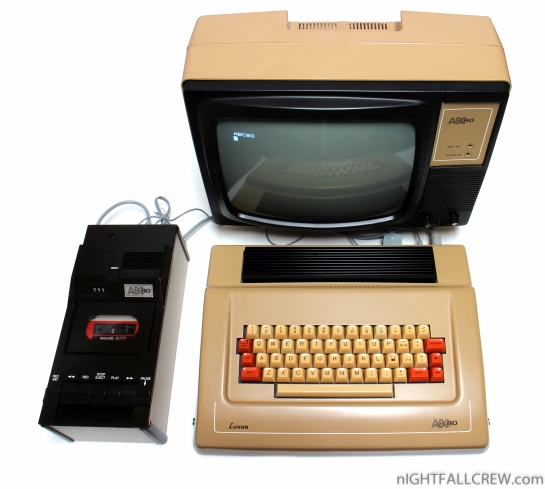
The ABC 80 (Advanced BASIC Computer 80) was a home computer engineered by the Swedish corporation Dataindustrier AB (DIAB) and manufactured by Luxor in Motala, Sweden in the late 1970s (first model August 1978) and early 1980s. It was based on the Zilog Z80 running at 3 MHz and had 16 KB RAM, expandable to 32 KB, and 16 KB ROM containing a fast semi-compiling BASIC interpreter.
ABC 80 normally used a dedicated (included) tape recorder for program and data storage, but could also be expanded to handle disk drives (and many other peripherals). Some sound effects could be produced by a Texas Instruments SN76477 sound chip which was connected to an 8-bit output port, but there was no way to control the chip’s features in any detail, so sound was limited to 96 fixed sounds. The monitor was a black and white TV set modified for the purpose (an obvious choice since Luxor also made TVs). The computer had excellent I/O response times, something that was discovered when trying to upgrade to personal computers. The solution was to use a microcontroller that communicated with a PC. The main unit had a reset button as well.
ABC 80 was also manufactured on license as BRG ABC80 by Budapesti Rádiótechnikai Gyár in Hungary. It used the same keyboard, but the case was metal instead of plastic.
The ABC 80 was a huge hit in Sweden, and grasped a majority share of the rising personal computer market thanks to its office software in Swedish. Although the ABC 80 fans would defend the ABC 80 by referring to its good BASIC and usable extension bus, it couldn’t defend the home market against the gaming computers with color graphics and better sound that arrived in the early 80s like the Commodore 64, even though a new cheaper version was released that could use an ordinary TV instead of the dedicated video-monitor.
Luxor held on to its office market for a couple of years longer with the ABC 800 series, which had a more extensive BASIC, more memory and a 512×240 ‘high-resolution’ graphics mode, but otherwise similar performance. In 1985 Luxor also tried to compete in the office market against the IBM PC with its ill-fated ABC 1600 and ABC 9000 series UNIX computers, but failed.
Gallery:
… and the boxes
Software:
source: wikipedia
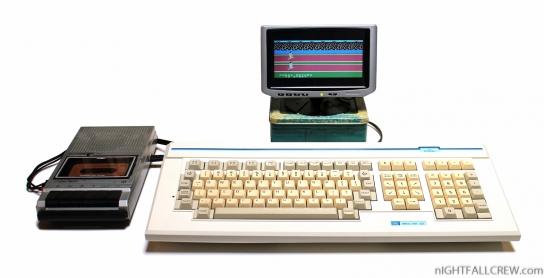
The Bruc 100 is one of the few home computer designed and manufactured in Italy by Frael (Franchi Electronics) . Released in the 1987 it was sold along with the computer courses of the School 2F.
There are two models. The first has no cartridge slot but only one extension BUS. On the second model the extension BUS has been replaced by a cartridge port.
The Bruc 100 is not totally an MSX1 computer. The cartridge port (or the extension BUS) and the cassette tape connector are a bit different. This computer doesn’t support the FM-Pac nor floppy disk controllers, etc because the port does not provide + 12V nor -12V. The cartridge port also has the particularity of having two /SLTSL signals (pin 4 for slot 2 and pin 16 for slot 3).
The Basic of Bruc 100 is not the MSX-Basic but it is very similar. The keyboard is a bit different from a MSX. There are 107 keys which a number pad, shortcut keys and some mirror keys.
Gallery:
Replacement of non polarized plug C7/C8:
source: computerhistory.it msx.org
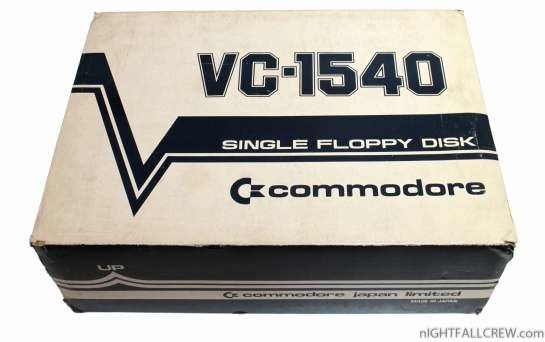
The Commodore 1540 (also known as the VIC-1540) introduced in 1982 is the companion floppy disk drive for the Commodore VIC-20 home computer. It uses single-sided 5¼” floppy disks, on which it stores roughly 170 kB of data utilizing Commodore’s GCR data encoding scheme. The launch price in Germany was 1898 DM (approximate 970 EUR). The US-American version is named VIC 1540 and the German version VC 1540.
Because of the low price of both the VIC-20 and the 1540, this combination was the first computer with a disk drive to be offered on the US market for less than $1000 USD, although the combination of the Commodore 64 and 1541 would prove more enduring. The 1540 is an “intelligent peripheral” in that it has its own MOS Technology 6502 CPU (just like its VIC-20 host) and the resident Commodore DOS on board in ROM – contrary to almost all other home computer systems of the time, where the DOS was loaded from a boot floppy and was executed on the computer’s CPU.
Due to a timing conflict with the C64′s video chip, the C64 doesn’t work properly with the 1540. The better-known 1541 is mechanically and nearly electronically identical to the 1540 but has a revised ROM that permits it to work with the C64 by slowing the drive down slightly. However, it is possible to revert the 1541 into 1540 mode with a Commodore BASIC software command (OPEN 15,8,15, “UI-” : CLOSE 15) to permit better speed when used with a VIC-20.
The 1540 is relatively rare. While cheaper than most other drives of the day, it was more expensive than the VIC-20 computer itself, and the disk media was also still relatively pricey. Also, the relatively small memory of the VIC meant that the faster program loading times of the drive did not gain more than a few seconds compared to tape media. Thirdly, almost all commercial software for the VIC-20 was sold on cartridge or cassette tape media, giving low incentive to buy a floppy drive. The C64 followed close on the heels of the VIC-20, quickly discontinuing the 1540. Most 1540s still in existence were modified with a 1541 ROM so it would work with a C64. Unmodified 1540s are now considered collector’s items.
Gallery:
source: wikipedia
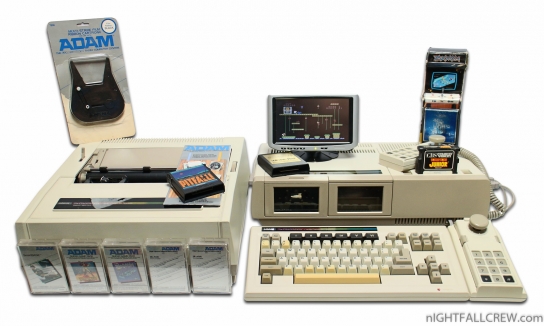
The Coleco Adam is a Home Computer, and expansion for the ColecoVision (port 3), released in 1983 by American toy manufacturer Coleco. It was an attempt to follow on the success of the company’s ColecoVision video game console. The Adam was not very successful, partly because of early production problems, and was orphaned in early 1985.
Coleco announced the Adam at the Summer Consumer Electronics Show (CES) in June 1983, and executives predicted sales of 500,000 by Christmas 1983. From the time of the computer’s introduction to the time of its shipment, the price increased, from USD $525 to $725.
Coleco’s 1983 announcement of the Adam received favorable press coverage. The Boston Phoenix, observing that the computer’s $600 price was comparable to the lowest price for a letter-quality printer alone, stated “a nice trick if they can do it!” It was, in fact, a trick; the computers were shown behind tinted glass that hid the fact that they were hand-made and had non-working tape drives.
In June the company promised to ship the computer by August. In August it promised to ship a half million Adams by Christmas, but missed shipping dates of 1 September, 15 September, 1 October, and 15 October. Ahoy! reported that Coleco had not shipped by early October because of various problems. Each month of delay could mean losing the opportunity to sell 100,000 units, the magazine reported, adding that missing the Christmas season would result in “inestimable losses”. The company only shipped 95,000 units by December, which were very defective; Creative Computing later reported that “the rumored return rate was absolutely alarming”. One store manager stated that five of six sold Adams had been returned, and expected that the sixth would likely be returned after being opened on Christmas. Coleco partnered with Honeywell Information Systems to open up repair chain stores around the nation. By December 1983 the press reported that company executives at a news conference “fielded questions about Coleco’s problems with its highly-publicized new Adam home computer, which has been plagued by production delays and complaints of defects”, with the company only able to fulfill one third of its Canadian orders for Christmas. Less than 10% of Adam units had defects, the company claimed, “well below industry standards”.
Gallery:
Gallery (Cleaning the Keyboard):
Gallery (The big Box & Under the Cover):
Adam ColecoVision Video (Daisy-wheel Printer Test / Tape Loading / Game Cartridge):
source: wikipedia
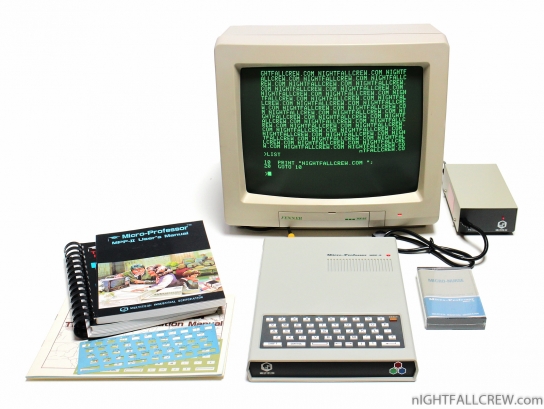
Microprofessor II (MPF II), introduced in 1982, was Multitech’s (later renamed Acer) second branded computer product and also one of the earliest Apple II clones. It does not look like most other computers. The case of the MPF II was a slab with a small chiclet keyboard on its lower part.
In 1983, the Multiprofessor II retailed in the UK for £269.00 including VAT.
One key feature of the MPF II was its Chinese BASIC, a version of Chinese-localized BASIC based on Applesoft BASIC. There was also a version sold in Europe that did not have Chinese localization.
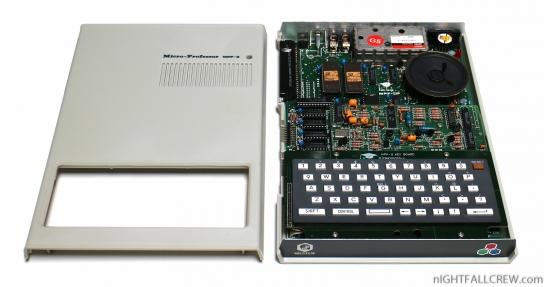
Differences to Apple II:
The MPF II was not totally compatible with the Apple II.
The MPF II did not have Apple II’s text mode. All the text was drawn on the screen by software rather than generated by hardware. It was the only cost-effective way to generate Chinese text on screen at a time when a hardware-based Chinese character generator could cost hundreds of U.S. dollars.
Like Apple II, MPF II had two graphics buffers. However the second buffer was at address A000H while with Apple II it was at 4000H. The keyboard input was mapped to a different address than the Apple II making impossible to play Apple’s games on the MPF II.
MPF-II keyboard interface was very simple and consisted of an 8 bit output port and an input port that were directly connected to keyboard matrix. The Apple joystick interface was not there, and instead the joystick appeared as a keyboard with arrow keys and two other buttons.
The external slot interface was also not compatible with the Apple II and could not use many standard interface cards including the Disk II controller.
Technical information:
Multitech Micro-Professor MPF-II – PapaTudo (Pacman Clone) by Microsoft:
Gallery:
Powersupply Pinout:

Multitech Micro-Professor MPF-II Loading TK-2000 Game:
Atari The Educator
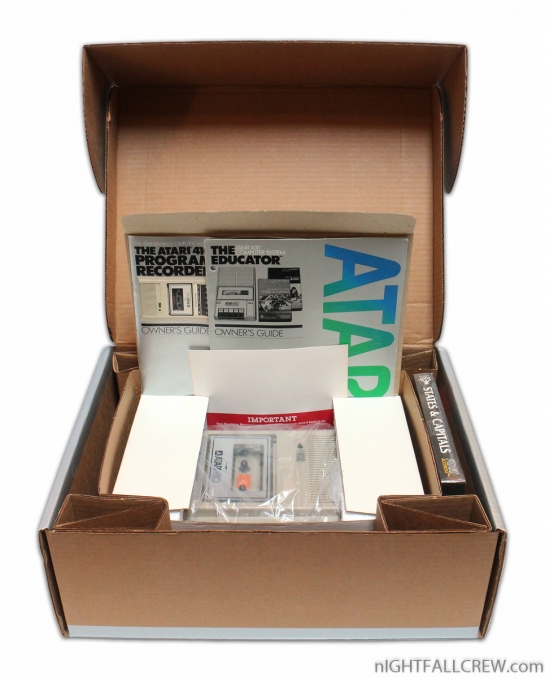
The package includes:
Download: Atari Educator Owners Guide (1851)
Atari 1025 80-Column Printer
Printer Specifications:
Atari 1030 Modem
With the introduction of Atari all new XL line of computers came the all new Atari 1030 direct connect modem. The modem had a very unique feature packed into it. Just like the Atari 850 interface, the Atari 1030 modem had not only its device driver in ROM which would automatically upload into the computers memory, but also its software as well.
The Atari 1030 came with an on-board software package called ModemLink which would automatically upload into the computers memory. However there was a catch, like all previous Atari software, ModemLink had no provisions for Uploading or Downloading software, also in order to use the on-board ModemLink software any disk drives that were connected to your system had to be turned OFF.
Later Atari 1030′s were packaged with “The New Atari 1030 Software Package” which was a diskette with Amodem, Tscope and DiskLink software. Amodem was written by Jim Steinbrecher of Atari telecom fame, Tscope was written by Joe Miller and was for use with Compuserve.
Gallery:
source: atarimuseum.com

Gallery:
The HP-67 was a magnetic card-programmable handheld calculator, introduced by Hewlett-Packard in 1976 at an MSRP of $450. A desktop version with built-in thermal printer was sold as the HP-97 at a price of $750.
Marketed as improved successors to the HP-65, the HP-67/97 were based on the technology of the “20-series” of calculators (HP-25, HP-19C etc.) introduced a year earlier. The two models are functionally equivalent, and programs on magnetic cards can be interchanged between them.
Features:
The 67/97 provide a complete set of scientific, statistical and engineering operations, including trigonometrical, logarithmic and exponential functions, coordinate conversions, average/deviation etc.
The HP-67/97 series featured a program memory of 224 eight-bit words. The two extra bits per word compared to the HP-65′s six allowed the designers to store any program instruction in a single memory cell (“fully merged keycodes”) even if it required multiple keystrokes to enter (see image). Programs could include 20 labels, subroutines (3 levels deep), four flag registers, 8 comparison functions, and extended index and loop control functions.
At 15 digits, the display was wider than those of the predecessor models, although the decimal point was displayed on its own digit position. The HP-67 keys carry up to four functions each, accessed through “f”, “g” and “h” prefix keys (gold, blue and black labels, respectively). The model 97 had more (and larger) keys, therefore only two functions were assigned to each key. When interchanging magnetic cards between the HP-67 and the HP-97, the calculators’ software took care of converting the key codes, and emulated the 97′s print functions through the 67′s display.
The HP-67 is powered by a pack of three AA-sized nickel-cadmium rechargeable batteries. Owing to the power requirements of the built-in thermal printer, the HP-97 employs a larger battery pack and more powerful charger.
Memory and programming:
Of the 26-register data memory, the first ten (“primary registers”) could be accessed directly, ten more as an alternate register set, and the remaining six had special functions for statistical operations and as an index register. Using the latter, a program could access all 26 registers as a single indexed array. Data memory is not permanent as in later models, i.e. register contents and program are lost when powering off.
The built-in magnetic card reader/writer could be used to save programs and data, with the ability to combine data from multiple cards. The same magnetic card format was later used for the HP-41C which offered compatibility to the 67/97 through software in the card reader. HP offered a library of programs supplied on packs of pre-recorded magnetic cards for many applications including surveying, medicine, as well as civil and electrical engineering.
In addition to software and support from HP, an active user community supported the HP67/97 as well as the other HP programmables of the era. The group was called PPC and produced the PPC Journal. One of the notable contributions of the group was the development of a “Blackbox” that allowed pseudo-alphanumeric displays.
Gallery (Before cleaning):
Gallery (Replacement Drive wheel & Battery):
Gallery (Under the Cover):
Download:
source: wikipedia.com hpmuseum.org
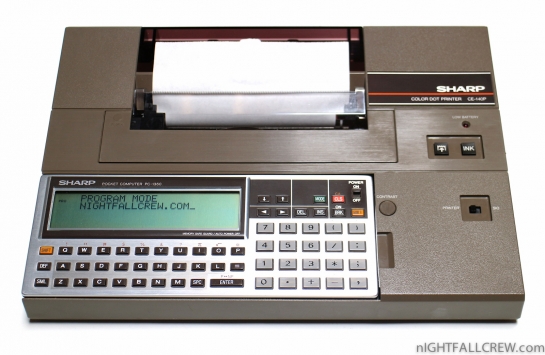
For this donation i thank: Andrea C. from Trieste.
The Sharp PC-1360 is a small pocket computer manufactured by Sharp. it can also be considered as an electronic calculator.
The PC-1360 was introduced in 1987 and was used by engineers, and favored by programmers for its decent programming and graphical capabilities. It was the top model of the (very small, only two models) 13XX series. It has a LCD display with four lines, also the SC61860 CPU, two RAM extension slot which work with the cynox RAM cards, a 15 pin serial interface and also a powerful BASIC. This is the best models for graphic applications.
Gallery:
source: computinghistory.org.uk
Recent Comments